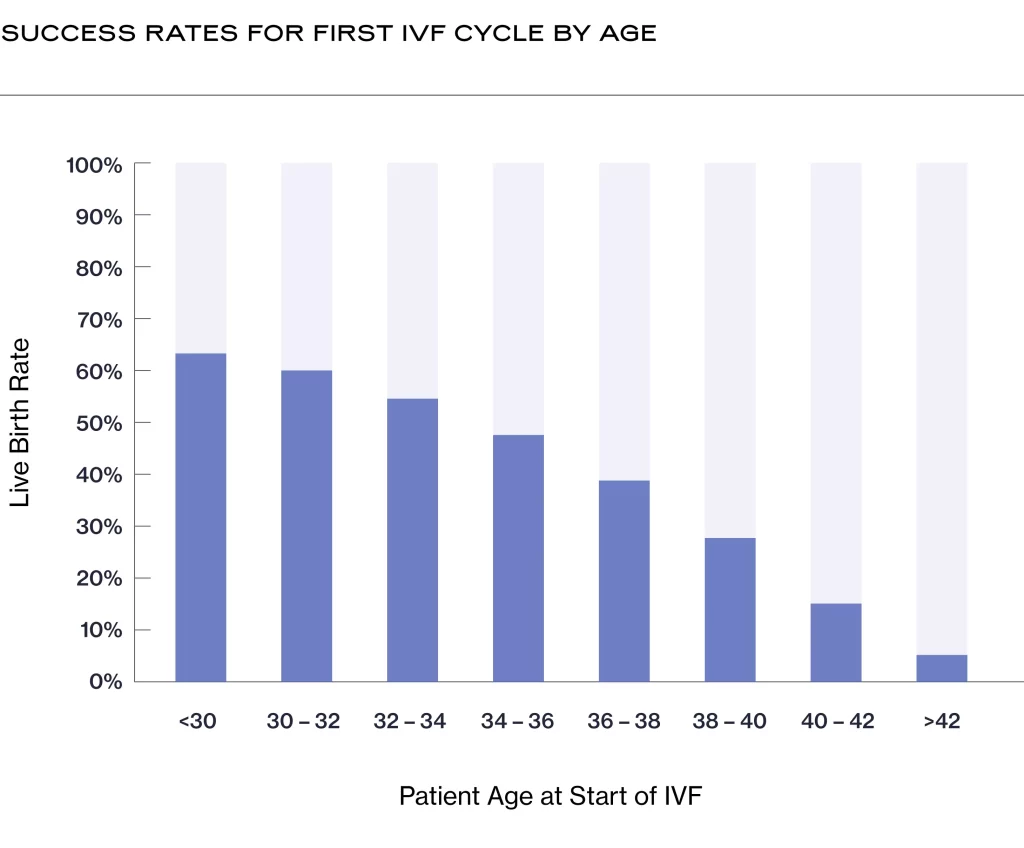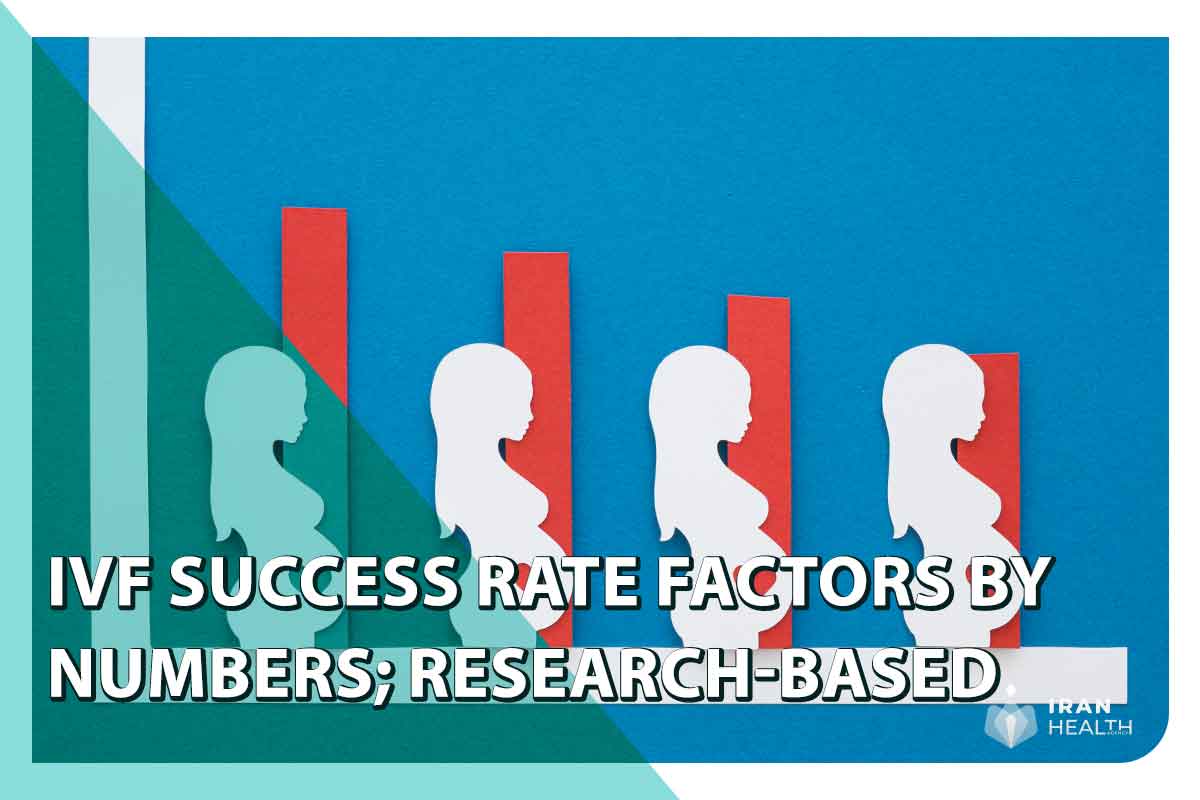Fertility treatments come with uncertainties; however, understanding the different factors that affect success rates, like age, health problems, specific fertility issues, and the chosen treatment, can greatly improve the chances of good results. By learning about these factors and talking to their healthcare providers, patients can make smarter choices and manage the challenges of their fertility path more effectively.
IranHealthAgency shares research-based insights into what affects IVF results, from age to embryo quality. Explore why factors such as treatment expertise and advanced technology make IVF in Iran a promising choice for couples seeking high success rates and effective treatments.
1. IVF success rate by Age
Generally, the chances of IVF working for you can depend on your age. I’ve got a chart here that shows you all the details.
| Age Group | Success Rate (%) |
| Under 35 | 55.1%13 |
| 35-37 | 40.5%1, 40.8%2, 38.3%5 |
| 38-40 | 26.4%1, 25.1%5 |
| Over 40 | 8.2%13, 12.7% (41-42)5, 4.1% (over 42)5 |
Based on these rates, you can estimate your chances of getting pregnant after your first IVF cycle( Please do not get overly concerned; these are just general estimates and do not mean you have no chance beyond 35).
It’s crucial to remember that these numbers might change depending on unique situations and the effectiveness of the particular clinic.

We discussed age as a significant factor in IVF success rate factors (the most critical factor in IVF results), and now it’s time to mention another factor in summary for you.
2. Number of embryos transferred:
- Single embryo transfer: 30-40% success rate per cycle
- Two embryo transfer: 40-50% success rate per cycle
- Three or more embryo transfers: 50-60% success rate per cycle (but with a higher risk of multiple births)
3. Type of IVF:
- Conventional IVF: 40-50% success rate per cycle
- ICSI (intracytoplasmic sperm injection): 40-50% success rate per cycle
- Donor eggs: 50-60% success rate per cycle
- Donor sperm: 40-50% success rate per cycle
- Frozen embryo transfer: 40-50% success rate per cycle
4. Cause of infertility:
- Male factor infertility: 30-40% success rate per cycle
- Female factor infertility: 40-50% success rate per cycle
- Unexplained infertility: 40-50% success rate per cycle
- Tubal factor infertility: 30-40% success rate per cycle
- Endometriosis: 30-40% success rate per cycle
5. Several previous IVF attempts:
- First IVF attempt: 40-50% success rate per cycle
- Second IVF attempt: 30-40% success rate per cycle
- Third or more IVF attempts: 20-30% success rate per cycle
6. Cumulative success rates:
- After three cycles: 60-70% success rate
- After six cycles: 80-90% success rate
Other factors:
- BMI (body mass index): Women with a BMI over 30 may have lower success rates
- Smoking: Smokers may have lower success rates
- Medical conditions: Certain medical conditions, such as polycystic ovary syndrome (PCOS), may affect success rates
- Quality of embryos: Embryos with better morphology and development may have higher success rates
You may need to break down the above information into more data with numbers; let’s review the stats:
ICSI vs. Conventional IVF:
The success rates of conventional IVF and ICSI (Intracytoplasmic Sperm Injection) are comparable. But when there are problems with male factor infertility, such as low sperm count or poor sperm quality, ICSI is frequently performed.
- A 2022 study published in Human Reproduction Update reported a live birth rate of 46.8% per cycle for ICSI and 43.2% for conventional IVF.
- A 2023 study in the journal Fertility and Sterility found a clinical pregnancy rate of 48.1% per cycle for ICSI and 44.7% for conventional IVF.
Success Rates for Donor Sperm vs. Egg Donation:
Donor eggs typically have a higher success rate than donor sperm. This is because eggs can be used successfully even at an older age, whereas sperm is less sensitive to the woman’s age and reproductive health.
- A 2023 research review published in the journal PLOS One reported a live birth rate of 58.4% per cycle for donor eggs and 45.7% for donor sperm.
- A 2022 study in Human Reproduction found a clinical pregnancy rate of 63.1% per cycle for donor eggs and 49.2% for donor sperm.
7. IVF success rate by location
Below are the countries with the highest probability of getting an answer from IVF (from highest to lowest rate).
| Location | Clinical Pregnancy Rate per Cycle (%) | Live Birth Rate per Cycle (%) |
| USA | 58.0 – 61.0 | 49.0 – 52.0 |
| UK | 54.0 – 57.0 | 45.0 – 48.0 |
| Australia | 52.0 – 55.0 | 44.0 – 47.0 |
| Canada | 51.0 – 54.0 | 43.5 – 46.5 |
| Germany | 50.0 – 53.0 | 42.5 – 45.5 |
| France | 49.0 – 52.0 | 42.0 – 45.0 |
| Iran | 46.0 – 49.0 | 39.5 – 42.5 |
| Turkey | 44.0 – 47.0 | 38.0 – 41.0 |
| Israel | 43.0 – 46.0 | 37.5 – 40.5 |
| UAE | 42.0 – 45.0 | 37.0 – 40.0 |
| Saudi Arabia | 41.0 – 44.0 | 36.5 – 39.5 |
| Egypt | 40.0 – 43.0 | 36.0 – 39.0 |
| India | 39.5 – 42.5 | 35.5 – 38.5 |
| China | 39.0 – 42.0 | 35.0 – 38.0 |
Glossary of terms
- The live birth rate per cycle is the percentage of cycles that result in a live birth.
- The clinical pregnancy rate per cycle is the percentage of cycles that result in a clinical pregnancy (defined as a pregnancy confirmed by ultrasound).



